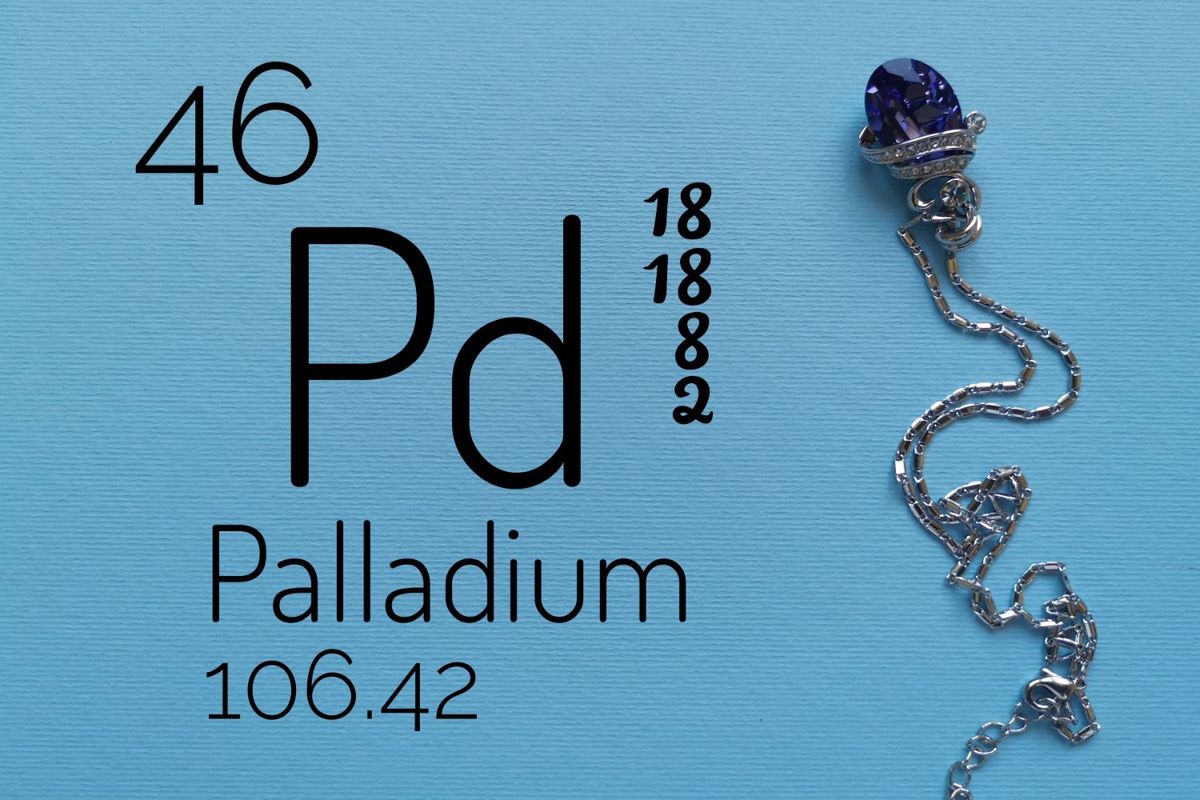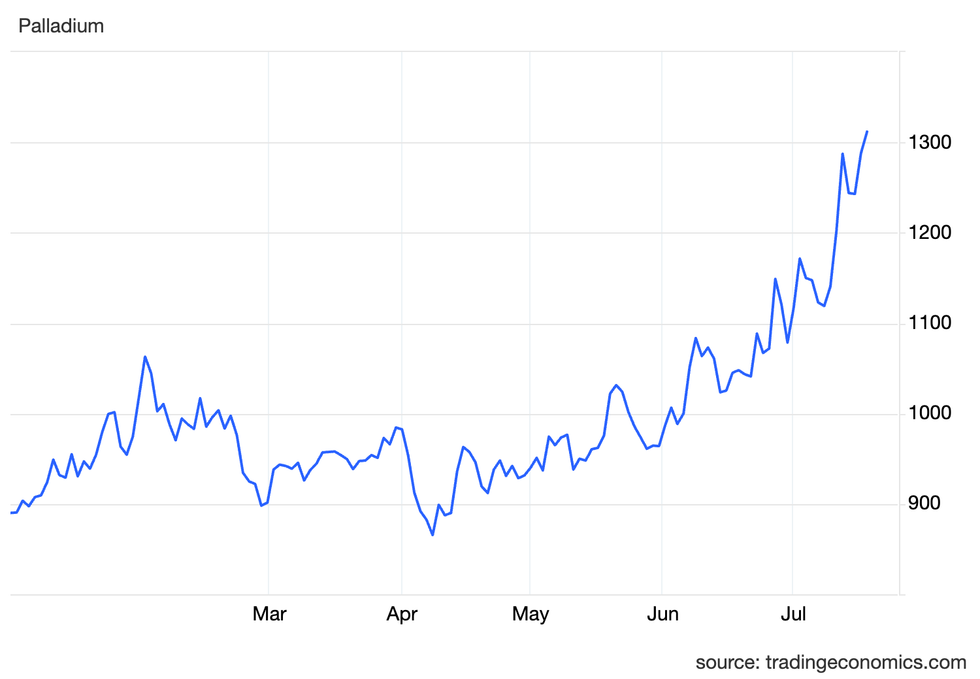Palladium Price Update: H1 2025 in Review
Supply/demand fundamentals, trade tensions and an end to EV tax credits in the US provided strong momentum for palladium in the first half of the year.

After peaking around the US$3,000 per ounce mark in February 2022, the palladium price has lost momentum.
The downward trend has occurred amid strong growth in demand for electric and hybrid vehicles, as well as cost-saving measures, with automakers swapping palladium for the less expensive platinum.
While platinum benefits from demand outside the automotive sector, including industrial applications and investment, palladium's primary use is within the automotive sector, and its performance is linked to it.
What happened to the palladium price in H1?
At the start of the year, palladium was trading in the US$900 range, but it had upward momentum, and with steady increases, it broke through the US$1,000 mark on January 24.
Palladium continued on to reach its first quarter high of US$1,063 on January 31.
Downward pressures on the palladium price resumed in February as the price sank back under US$1,000, reaching US$898 on February 27. As March began the palladium had some gains, but failed to breach the US$1,000 mark, closing the first quarter at US$984 on March 31.

Palladium price, January 1 to July 17, 2025.
Chart via TradingEconomics.
Tariff announcements at the start of April led to steep declines across commodity markets, and the palladium price dropped to a year-to-date low of US$866 on April 8.
However, as tariffs were paused, palladium continued its upward trend for the remainder of Q2. It once again broke through the US$1,000 mark at the end of May, reaching US$1,031 on May 21.
It briefly retracted once again at the end of May, but as June began, the price took off once more, first reaching US$1,149 on June 26 and continuing to set a year-to-date high of US$1,288 on July 11.
Palladium supply and demand in H1
In its Platinum Essentials report, released on June 19, the World Platinum Investment Council outlines its five year forecast for both the platinum and palladium markets.
In 2024, total palladium supply increased to 9.42 million ounces, up from 9.09 million ounces in 2023, while total demand declined to 10.04 million ounces from 10.24 million ounces in the previous year.
The data showed that the most significant area of decline was the softening demand from the automotive sector, which decreased to 8.1 million ounces from 8.5 million ounces in 2023. The differential led to a 624,000 ounce supply deficit, notably less than the 1.15 million ounce shortfall recorded the previous year.
Looking ahead, the council expects the deficit to shrink to 120,000 ounces in 2025, before posting a surplus of 125,000 ounces in 2026 and building to a surplus of 689,000 ounces in 2029.
On the supply side, the expectation is that total supply will decline slightly to 9.3 million ounces in 2025 and then increase to 10.06 million ounces by 2029. Breaking it down, mining supply is forecast to drop off over the next five years, from 6.4 million ounces in 2025 to 6.28 million ounces in 2029.
The decrease in raw inputs, however, will be offset by increases in recycling, particularly as vehicles with higher palladium loadouts are taken out of service. This prediction is that autocatalyst recycling will account for 2.9 million ounces in 2025 and is expected to grow to 3.78 million by 2029.
On the demand side, the expectation is for continued declines. The council is forecasting total demand to reach 9.42 million ounces in 2025, as requirements from the automotive sector are expected to decline to 7.7 million ounces. Further out, the council forecasts demand to remain relatively steady, with 9.37 million ounces in 2029, with the auto sector accounting for 7.6 million ounces.
Why is the palladium price rising?
Many of the same factors affecting the platinum market are at play for palladium.
Among them is an increase in investment demand, which is happening as investors seek safe-haven assets to bring stability to their portfolios. This is due to the chaos caused by shifting trade policies from the US, as well as escalating conflict in the Middle East at the end of the year's second quarter.
Dana Samuelson, president of American Gold Exchange, told the Investing News Network (INN) that the 100 to 1 ratio between silver and gold has prompted investors to explore different opportunities.
“The gold-to-silver ratio went over 100 to one about a month and a half back. I guess it made people who have been in gold say, look, there’s opportunity in silver, because it’s so underpriced relative to gold, but there’s also opportunity in platinum and palladium,” he said. Samuelson pointed to the price increases that followed US President Donald Trump's rollback of U.S. tariffs on Chinese goods in May and noted how investors were bullish on the metals market.
“They wanted to stay in the metal sector, but they wanted to find opportunities in other metals, so they rotated into silver, platinum and palladium. We’ve seen both platinum and palladium make some pretty good surges, too. I think that caused a shift within the sector, which is now benefiting,” he said in the July 9 interview.
Palladium is also experiencing upward momentum due to speculation within the auto sector following Trump's signing of the One Big Beautiful Bill into law on July 4. Among the provisions in the bill are an end to electric vehicle (EV) tax credits that provided up to US$7,500 to consumers who purchased an EV.
The end of the program comes as EV demand in the US has stalled out, and many expect that more consumers will turn to traditional internal combustion vehicles or hybrids, both of which have higher platinum group loadouts than EVs.
Palladium price forecast for 2025
Even more than platinum, palladium is dependent on demand from the auto sector.
With trade and an escalating trade war, considerable uncertainty exists in the market right now. Rising prices due to tariffs could soften consumer sentiment and pull the economy into a recession.
That would reduce demand for new autos and, in turn, reduce demand for platinum group metals like palladium.
However, a US recession may not trigger a global recession, and the US is no longer the world's top car market.
In an interview with INN on June 16, Jeffrey Christian, managing partner at CPM Group, highlighted China’s dominance as the world's largest automobile market.
“Half of the autos being sold in China are battery EVs that don’t use PGMs. Of the other half, they’re mostly gasoline-powered vehicles, so they will use palladium-intensive catalysts; however, they also tend to be smaller vehicles than those used in North America … So, you know, I guess there’s some bullishness on the part of speculators that, hey, palladium has been trading in this range too for several years, and maybe it’s time for a revival,” he said.
For his part, Samuelson sees some potential upside for the price.
“I do think palladium is cheap at US$1,150 or thereabouts. I think it should be US$1,300 or US$1,400, close to on par with platinum, because it’s actually scarcer and used in automobile catalytic converters, and gasoline engines aren’t going anywhere anytime soon,” he explained.
Don't forget to follow us @INN_Resource for real-time updates!
Securities Disclosure: I, Dean Belder, hold no direct investment interest in any company mentioned in this article.
Editorial Disclosure: The Investing News Network does not guarantee the accuracy or thoroughness of the information reported in the interviews it conducts. The opinions expressed in these interviews do not reflect the opinions of the Investing News Network and do not constitute investment advice. All readers are encouraged to perform their own due diligence.
- Top 5 Palladium- and Platinum-producing Countries ›
- How to Invest in Palladium ›
- What is the Best Precious Metal to Invest In? ›
